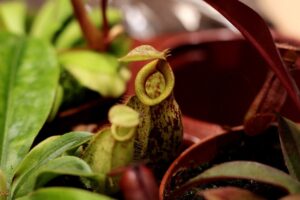
Move over, venus flytrap – there’s a new carnivore in town.
Nepenthes, which is often called the monkey cup or tropical pitcher plant, is rather exotic looking. From its tendrils you’ll see globe- or tube-shaped protrusions that act as traps. In the tropics, monkeys are often seen drinking rainwater from these “pitchers” which is how it got its most popular nicknames.
However, if you are smaller than a monkey, you might want to watch out. While insects are the primary diet for Nepenthes, larger versions of the plants in the wild have been known to trap rats, lizards and even the occasional bird. (Yikes – cue the “Little Shop of Horrors” soundtrack.)
Not to worry, however; the hybrids we offer at Warner’s will most likely stick to bugs.
Caring for Your Nephentes
- Light – These plants love bright (although not direct) sun. A nice windowsill with bright light is perfect for this plant, which needs a hefty dose of light to develop its “pitchers.” Just make sure the plant doesn’t scorch, which will show up as red zones on the plant’s upper most growth.
- Humidity – Although this plants roots are in the tropics, you don’t have to have a hothouse to grow a Nepenthes. They’ll tolerate lower humidity although they probably won’t develop as many pitchers. A terrarium is a great choice for this plant, however, because of the increased humidity it provides.
- Soil – Your medium for this plant should be a mix of moss and perlite, not potting soil (the minerals in potting soil will actually damage the plant).
- Water – Don’t let your Nephentes dry out completely. On the other hand, standing water is a bad idea as it causes root rot.
- Temperature – As you would expect with a plant that comes from the tropics, Nephentes doesn’t like the cold. Please keep it away from the air conditioner or drafts.